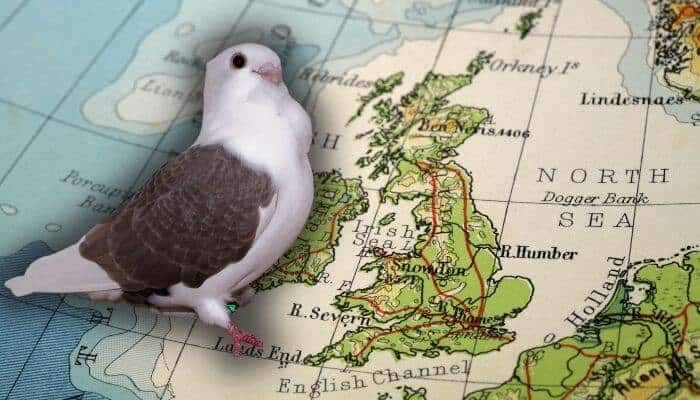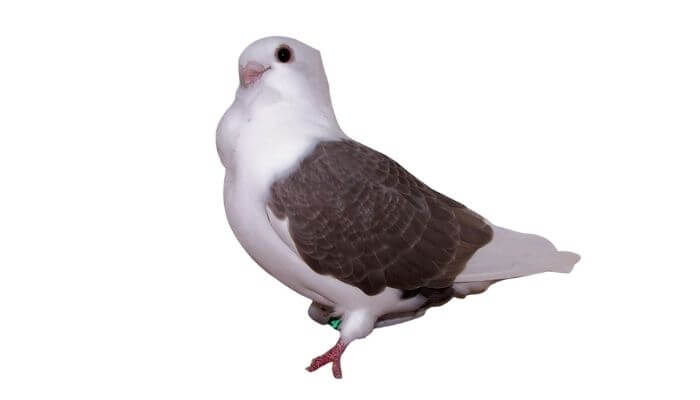The Turbit is a breed of fancy pigeon known for its short beak, peaked crest, and frilled breast.
It is sometimes known by other names including the Cravate Turbit, the Turbitmovchen, and the Turbito.

There are also variations of the breed – the Old Dutch Turbit and the Oriental Turbit.
The name of the bird derives from the word ‘turbo’, which has the original Latin meaning of ‘spinning top’.
The bird is mainly bred for show purposes but they are also excellent flyers.
Origins of the Turbit Pigeon
The Turbit pigeon in its current standard form is believed to have been developed in the United Kingdom.
The general consensus is that the Turbit is a result of the cross mating between various breeds of Anatolian Owl and Show Antwerp.
Specific dates have not been pinned down but the consensus is that the Turbit has been around since the 17th or 18th century.
Known references are by Willubhy in 1679 and Moore in 1785.
As an Amazon Associate I earn a small fee from qualifying purchases made through Amazon links. This helps us run the site – thanks for your support!
It was once a hugely popular breed and is the subject of a book, The Turbit Pigeon by Rev. F.W. Lumley, written in 1894.

Distribution And Habitat of the Turbit Pigeon
Being first and foremost a kind of domestic fancy pigeon, there is little to say about any natural habitat a Turbit might prefer.
Generations of domesticity in various countries across the world, primarily in Europe, have seen the breed become very comfortable and adaptable to the traditional kinds of fancy pigeon setups in the homes of dedicated and expert breeders and fanciers.

The largest concentration of Turbits can be found across mainland Europe and in the United Kingdom, but there is still a healthy but smaller population among the bird fanciers in places like the United States where there is a national Turbit Pigeon Club.
Australia also has an Owl, Frill, and Turbit Club.
Turbit Pigeon Appearance
The Turbit is a small to medium-sized bird that has a very compact body.
| Wingspan | Length | Weight | Colouring | |
|---|---|---|---|---|
| Turbit | 60 – 70 cm | 28 – 32 cm | 225 – 290 g | White with coloured wings |
| Average Feral Pigeon | 64 – 72 cm | 32 – 37 cm | 300 – 500 g | Bluish grey with some black |
The turbit boasts an erect but graceful carriage and can be easily distinguished thanks to its short beak, peaked crest, and flamboyant frill of feathers on the breast just below the neck.
The body of a Turbit is most commonly white in colour with coloured wings.
It has a relatively large head in comparison to the rest of its body. The turbit head was the subject of much debate and experimentation in the breeding stages until the ideal was settled upon.
Its neck is broad and very slightly arched, and it has large, prominent eyes that have white ceres to match the most common colouring.
The legs are of medium size and are almost always red in colour.
Though white is the most common colour, turbits can also be black, blue, red, dun, yellow, silver, cream and mealy. Purists will always aim for white.
Smaller than your average common pigeon, generally, a mature Turbit pigeon will weigh between 220 and 290 grams.
Character of Turbit Pigeons
The Turbit is known for having a very pleasant and steady temperament, and this makes them an ideal choice of bird for show purposes.

They are excellent flyers, and this suggests an intelligence that some other birds of their size and breeding don’t necessarily have.
Turbits are good for raising as pets and are equally as good in the role of a first bird breed for anyone thinking about getting into the world of pigeon fancying.
Turbit Pigeon Diet
The diet of a Turbit pigeon is pretty much the standard of what a pigeon eats.
Their main food will be a mix of seeds, grains, cereals and nuts that the owner will either buy or mix themselves.
They might be given the occasional treats of banana or popcorn.
Owners who enter their birds in flying exhibitions may use pigeon conditioner to get them into peak shape. The birds also need a constant supply of fresh water.
Mating And Breeding Turbit Pigeons
Mating and breeding is very much dictated and controlled by individual owners.
Couples are chosen for specific ideal traits that they might have including colouring, size, temperament, and overall health.
This is to ensure that their next generation of Turbits continues to boast the qualities that are seen as being the standard for the breed.
Also Read: Dutch Cropper Pigeon: Breed Guide
Caring for Turbit Pigeons
There are no special requirements when it comes to caring for a Turbit pigeon.
They can thrive in the same kinds of traditional conditions and habitats that most other fancy pigeons enjoy.
Being excellent flyers, you do want to make sure that the birds have access to the outdoors, combined with a clean loft that is well maintained.
They are known for being very low maintenance birds, but that doesn’t mean that you can take your eye off the ball in terms of providing a Turbit with everything that it needs including a clean living environment, plenty of space a nice full bird feeder and water bowls.
